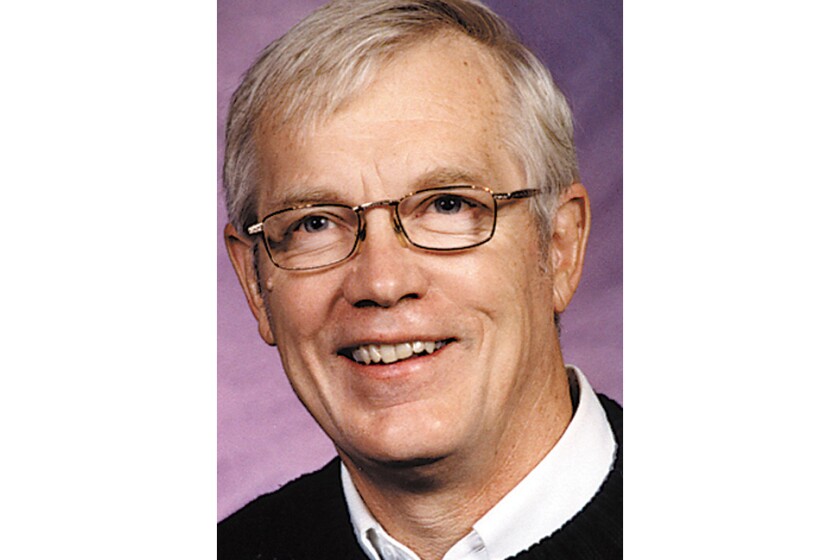I am reading the Bible for the third time, cover to cover.
Every time I read it, I am somewhat embarrassed because this book of love is also filled with sexual innuendos, violence and the deaths of thousands upon thousands of people.
ADVERTISEMENT
Should it be banned? It’s like an X-rated movie: sex, violence and killing.
The Bible is intended to bring hope to Christians, which it does. The Bible also makes me aware of man’s inhumanity to man. Should we subject our children to the Bible’s sexual, racial and mean-spirited content? Is this a book that we really want our children to read?
Increasingly and for the past couple of decades, educators have faced issues of defending what books they can place on the library bookshelves and what books English and literature teachers can have their students read.
From my many years in education, I have always trusted a teacher’s decision. If there were an issue, teachers reached out to parents and gave their students a choice of reading a particular book or not reading it. They are aware of the controversy that can be raised about what students read.
Let me put parents’ minds at rest. Teachers do not corrupt the minds of students. We have students read books because they make them think, ask questions and formulate opinions.
This is what freedom is all about. We don’t want young people to have minds of “mush.” We want students to be informed.
I trust teachers to guide students when discussing controversial topics. Being uninformed about issues can be detrimental to everyone’s health. Think of what happened in Germany during WWII when German citizens were not privy to the truth about Jews.
ADVERTISEMENT
Our Constitution is like a book. What if it were banned and only certain people could read it, and outsiders were punished if they read it? Why would we ban the Constitution? Well, some parts are controversial.
Has the Constitution caused us to think and to ask questions? As a result of this thinking and questioning, do we have a stronger nation?
When “Peyton Place” was first published in 1956, Grace Metalious' novel shocked the world. Deemed “trash” by many, the book was banned in multiple cities and countries, including Canada.
“Peyton Place” sold more than 30 million copies. I remember my mother hid the book in her dresser drawer (now I wonder how I knew that). It was akin to a Dick and Jane reader by today's standards. I don’t have any data to support this, but I am sure 1956 reading test scores in public schools skyrocketed.
If we aim to improve reading in our schools, let’s have a “banned book” section in our libraries. I think the shelves would be forever empty, with long waiting lists of interested readers. Non-readers would all of a sudden have an interest in reading. Reading scores would soar.
Yes, I am being facetious, but banning books can get out of hand quickly.
In this “banned books” section, we might have books like “The Kite Runner,” which is the story of two boys growing up in Afghanistan against the backdrop of the Soviet invasion. Students not allowed to read the book could see the movie by the same name.
ADVERTISEMENT
Sherman Alexie's book, "The Absolutely True Diary of a Part-Time Indian," was subjected to school bans 16 times during the 2021-2022 school year. It was first released in 2007 and has been controversial due to its subject matter.
The novel is semi-autobiographical, based on the Native American author's life, and won a National Book Award in 2007.
Also in our section, we would find "The Bluest Eye" by Toni Morrison. It follows a Black girl who believes she is ugly and would be more beautiful if she only had blue eyes.
Believe it or not, two of the top 10 books banned in 2003 were the Harry Potter series by J.K. Rowling because they dealt with the occult and satanism.
“Of Mice and Men” by John Steinbeck was also on a banned book list due to its offensive language. The Captain Underpants series was also banned due to its sexually explicit nature and foul language.
“The Catcher in the Rye” by J.D. Salinger has made the banned book list along with the “Adventures of Huckleberry Finn” by Mark Twain and the book “The Color Purple.”
When you see these titles you can realize how ridiculous book banning can become. Interestingly, no one has suggested we should ban the Bible. No doubt, somebody has.
ADVERTISEMENT
Other writers included on blacklists in the past were American authors Jack London and Helen Keller. Keller’s belief in social justice encouraged her to champion people with disabilities, pacifism, improved conditions for industrial workers and women's voting rights.
Yes, intelligent as we are, we can also be very obtuse.
The burning of books under the Nazi regime on May 10, 1933, is perhaps the most infamous book-banning and burning event in history. Their goal was to eliminate outside influence and purify German culture.
It’s hard to believe that God-fearing people could do such a horrific act. What was the result?
Perhaps this is what the Bible is trying to teach us. To quote Bob Dylan, “But you tell me over and over and over again my friend, ah, you don’t believe we’re on the eve of destruction.”
If we wish to ban something, what is more dangerous, books or assault weapons?
Is it time to ban the Bible? Of course not. The question is about as absurd as "Should we ban books?"
ADVERTISEMENT
Riddle: What building has the most stories? (Answer: the library) Let’s try to keep it that way.
100%
I want to thank the Lutheran Campus Ministry for putting up 100% posters in their building.
John R. Eggers of Bemidji is a former university professor and area principal. He also is a writer and public speaker.








